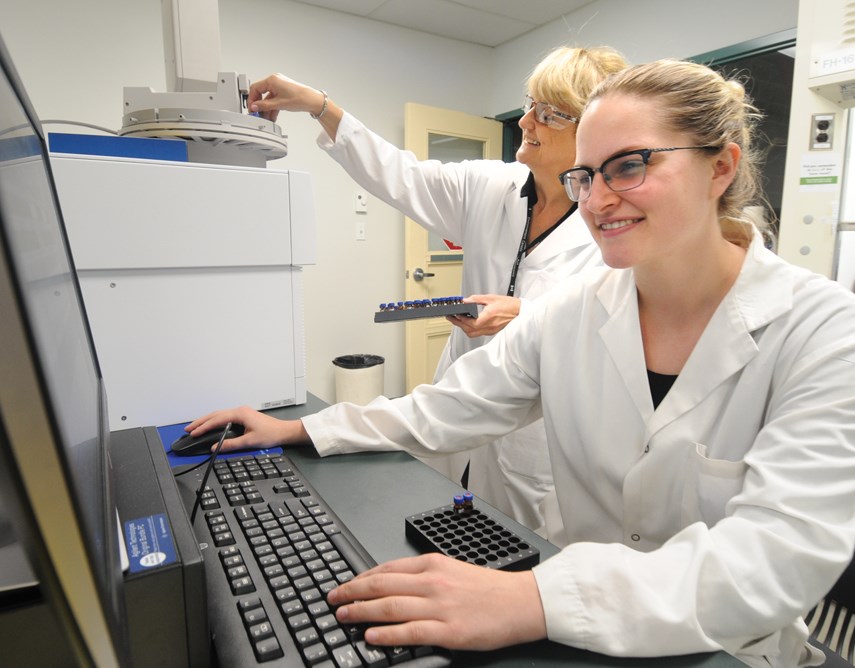The only witness isn’t talking – probably because he’s a dead fish.
In a lab on Dollarton Highway, just next door to the Maplewood Conservation Area, a team of scientists in white coats ply their trade as biologists and chemists. But in a broader sense they’re also detectives, using mass spectrometers and strong chemicals the same way an interrogation room cop might use a sympathetic look or a proffered cigarette to get his witness to talk.
“We’re not a world class research lab but we solve world class problems,” explains chemist Dayue Shang. “We are here to deal with any oil spill situation, any unknown chemical spill.”
When a cargo ship slopped approximately 2,700 litres of bunker fuel across English Bay in 2015, a sample was rushed to this lab, the Pacific Environmental Science Centre, for analysis that night. The vial hopped through their triage queue and moved to the concentration phase, where lab technicians sometimes reduce a one-litre sample to 0.1 millilitres, Shang says.
From that miniscule sample they can find chemical traces on a parts per trillion scale. If you put a sugar cube in a swimming pool they would dilute the sample before figuring out if the cube was stevia or Rogers.
But more challenging than seawater or even inorganic samples like heavy metals or ammonia, are the fish, Shang says.
Before analysis can even begin, a fish has to be “digested,” a process in which it’s dissolved with strong chemicals. Following that, they might use a liquid chromatography triple quadrupole mass spectrometer.
That mouthful of a machine uses a solvent and an adsorbent to help scientists figure out what’s what in a given sample. Much like everyone in your family reacts differently to Game of Thrones, every component in the sample has a different reaction to the adsorbent.
Based on those reactions each component can be separated. It’s similar to the way Superman uses his ultra-hearing to filter out everything except what Lex Luthor’s plotting.
Discussing the crises that have kept the lab’s 45-50 technicians busy since the place opened, Shang mentions the 2007 pipeline puncture in Burnaby that spewed about 224,000 litres of heavy crude into the environment.
Approximately 78,000 litres of oil seeped into the Burrard Inlet, prompting crews to use oil dispersants.
“If something happens, we may have to use it again,” Shang says of the dispersants.
By cutting globs of oil into microscopic, floating droplets, the dispersants are tantamount of a divide and conquer approach when it comes to diluting spilled oil.
It’s a subject of interest for lab technician and chemist Ceara MacInnis.
“We’re looking at how long it persists in the environment and what we should be using as an indicator to trace it,” she says.
With a little help from Shang and fellow lab technician Pam Brunswick, MacInnis recently published a paper on oil dispersants and how they affect the environment, specifically fish like rainbow trout, coho, chinook and chum.
While critics have paid close attention to possible environmental impacts in the event of a diluted bitumen spill from an expanded Kinder Morgan pipeline, it is also “essential to study effective oil spill response techniques,” MacInnis writes.
To better understand the issue, the lab turned 20-litre glass tanks into microcosms with seawater, rainbow trout from Mission, chum from the Capilano Salmon Hatchery, as well as an assortment of coho and chinook. Oil dispersant and lightly-weathered dilbit were introduced into the environment.
“Because of the high viscosity of the dilbit, chemical dispersion did not occur readily,” MacInnis wrote in the paper, noting a 1:10 ratio of dispersant to dilbit needed to be used.
The amount of dispersant used was intended to determine the toxicity associated with a single application of dispersant in the Pacific Northwest.
“All of the fish species under study died within 24 hours of experiment start,” MacInnis wrote.
The study also found that the percentage of recovery of the dispersant, dioctyl sulfosuccinate, dropped from 98 per cent to 19 per cent by the fourth day of the study. By day seven, the percentage of recovery dropped to one per cent.
On the other side of the lab, Pam Brunswick is at the quadrupole time-of-flight mass spectrometer.
“This is my favourite,” she says. “It’s not just a normal mass spectrometer that only goes to one digit at the decimal place.”
This spectrometer has been a key tool in measuring naphthenic acids in the Athabasca River.
As oil is extracted from the Athabasca oil sands there’s concern of naphthenic acids leaching into the groundwater and causing long-term health risks.
But finding out just where the problem is coming from can be a problem, particularly if there are a number of tailings ponds in close proximity.
But the specificity of the spectrometer should allow researcher to determine the guilty tailings pond like they were pointing out the criminal in a police lineup.
“We think it’s going to be really useful in the field for determining which ponds anything in the ground has come from” Brunswick says.
For his work, Shang has worked on unknown chemical identification of pesticides, herbicides, “every cide,” he says.
But generally, a major focus of the lab is Canada’s Ocean Protection Plan.
“Any oil spill, if it’s large enough, samples will be sent to this lab,” he says.
Earlier in June, the lab recently opened its doors for a rare public open house, marking a different approach to community relations than in previous years.
“It’s much more open,” Shang says, discussing a shift that came with the current federal government.
“We want the public to be aware that there’s a government lab hidden in the North Shore which is ready for all eventualities.”



